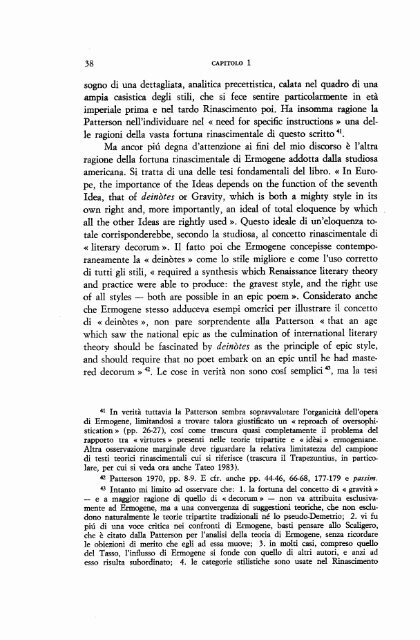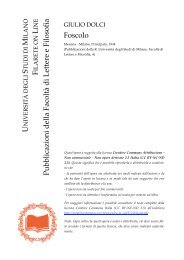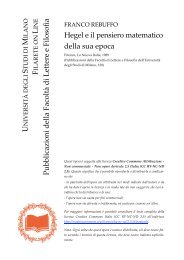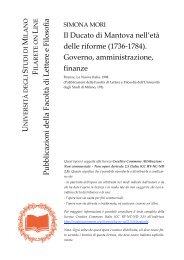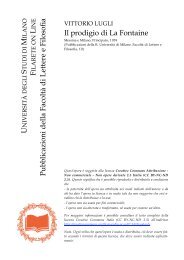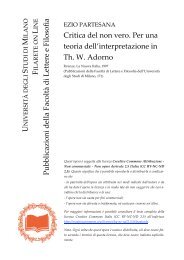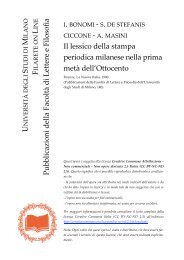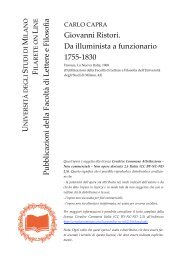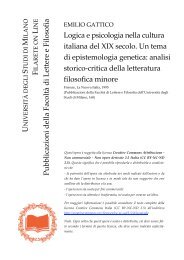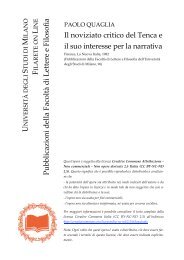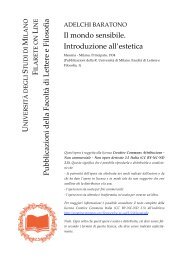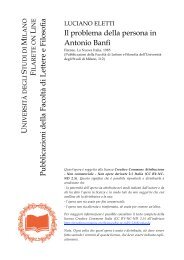U S M F L P u bblicazion i della Facoltà di Lettere e Filosofia La ...
U S M F L P u bblicazion i della Facoltà di Lettere e Filosofia La ...
U S M F L P u bblicazion i della Facoltà di Lettere e Filosofia La ...
You also want an ePaper? Increase the reach of your titles
YUMPU automatically turns print PDFs into web optimized ePapers that Google loves.
38 CAPITOLO 1<br />
sogno <strong>di</strong> una dettagliata, analitica precettistica, calata nel quadro <strong>di</strong> una<br />
ampia casistica degli stili, che si fece sentire particolarmente in età<br />
imperiale prima e nel tardo Rinascimento poi. Ha insomma ragione la<br />
Patterson nell'in<strong>di</strong>viduare nel « need for specific instructions » una del<br />
le ragioni <strong>della</strong> vasta fortuna rinascimentale <strong>di</strong> questo scritto 41 .<br />
Ma ancor più degna d'attenzione ai fini del mio <strong>di</strong>scorso è l'altra<br />
ragione <strong>della</strong> fortuna rinascimentale <strong>di</strong> Ermogene addotta dalla stu<strong>di</strong>osa<br />
americana. Si tratta <strong>di</strong> una delle tesi fondamentali del libro. « In Euro<br />
pe, thè importance of thè Ideas depends on thè function of thè seventh<br />
Idea, that of deinòtes or Gravity, which is both a mighty style in its<br />
own right and, more importantly, an ideai of total eloquence by which<br />
ali thè other Ideas are rightly used ». Questo ideale <strong>di</strong> un'eloquenza to<br />
tale corrisponderebbe, secondo la stu<strong>di</strong>osa, al concetto rinascimentale <strong>di</strong><br />
« literary decorum ». Il fatto poi che Ermogene concepisse contempo<br />
raneamente la « deinòtes » come lo stile migliore e come l'uso corretto<br />
<strong>di</strong> tutti gli stili, « required a synthesis which Renaissance literary theory<br />
and practice were able to produce: thè gravest style, and thè right use<br />
of ali styles — both are possible in an epic poem ». Considerato anche<br />
che Ermogene stesso adduceva esempi omerici per illustrare il concetto<br />
<strong>di</strong> « deinòtes », non pare sorprendente alla Patterson « that an age<br />
which saw thè national epic as thè culmination of international literary<br />
theory should be fascinated by deinòtes as thè principle of epic style,<br />
and should require that no poet embark on an epic until he had maste-<br />
red decorum » 42 . Le cose in verità non sono cosi semplici A3 , ma la tesi<br />
41 In verità tuttavia la Patterson sembra sopravvalutare l'organicità dell'opera<br />
<strong>di</strong> Ermogene, limitandosi a trovare talora giustificato un « reproach of oversophi-<br />
stication » (pp. 26-27), così come trascura quasi completamente il problema del<br />
rapporto tra « virtutes » presenti nelle teorie tripartite e « ideai » ermogeniane.<br />
Altra osservazione marginale deve riguardare la relativa limitatezza del campione<br />
<strong>di</strong> testi teorici rinascimentali cui si riferisce (trascura il Trapezuntius, in partico<br />
lare, per cui si veda ora anche Tateo 1983).<br />
« Patterson 1970, pp. 8-9. E cfr. anche pp. 44-46, 66-68, 177-179 e passim.<br />
43 Intanto mi limito ad osservare che: 1. la fortuna del concetto <strong>di</strong> « gravita »<br />
— e a maggior ragione <strong>di</strong> quello <strong>di</strong> « decorum » — non va attribuita esclusiva<br />
mente ad Ermogene, ma a una convergenza <strong>di</strong> suggestioni teoriche, che non esclu<br />
dono naturalmente le teorie tripartite tra<strong>di</strong>zionali né lo pseudo-Demetrio; 2. vi fu<br />
più <strong>di</strong> una voce critica nei confronti <strong>di</strong> Ermogene, basti pensare allo Scaligero,<br />
che è citato dalla Patterson per l'analisi <strong>della</strong> teoria <strong>di</strong> Ermogene, senza ricordare<br />
le obiezioni <strong>di</strong> merito che egli ad essa muove; 3. in molti casi, compreso quello<br />
del Tasso, l'influsso <strong>di</strong> Ermogene si fonde con quello <strong>di</strong> altri autori, e anzi ad<br />
esso risulta subor<strong>di</strong>nato; 4. le categorie stilistiche sono usate nel Rinascimento


